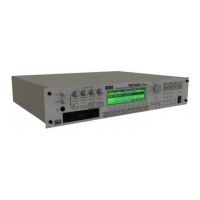88
If the buffer into which data was placed by the “Copy”
command contains no data, the display will indicate
“Source sample is empty.”
Pasting to a sample that contains no sample data
1 Select the vacant sample number that you wish to paste.
If you select ----:---No Assign---- for “Sample” and then
access the dialog box for this command, a vacant sample
number will be selected automatically.
The “S (Edit Start Range)” and “E (Edit Range End)”
(2.1–1b) settings will be ignored, and will have no
effect. The beginning of the sample will be placed at
address 0.
2 Select “Paste” to open the following dialog box.
3 In “Save to No.,” specify the save destination sample
number. If you wish to change it, re-specify the desired
number.
If the sample data loaded into the buffer by
“Copy” is stereo, the display will indicate “Save to
No.(L)” and “(R).” Specify the save destination sample
number for the L channel and the R channel.
4 To execute the “Paste” command, press the [F8] (“OK”)
key. To cancel without executing, press the [F7] (“Can-
cel”) key.
Insert Zero
This command inserts zero-level sample data (silence),
beginning at the “S (Edit Range Start)” address. The data
that previously occupied that location will be moved back-
ward.
1 Use “SMPL” (2.1–1a) to select the sample that you wish
to edit, and set “S (Edit Range Start)” (2.1–1b) to specify
the starting address. The “E (Edit Range End)” setting is
ignored.
2 Select “Insert Zero” to open the following dialog box.
3 To “Start” will indicate the starting address at which the
data will be inserted.
4 In “Size,” specify the length of the data that will be
inserted.
5 In “Save to No.,” specify the save destination sample
number. By default, an unused sample number will be
selected. If you have checked “Overwrite,” this cannot be
set.
For a stereo sample, “Save to No.(L)” and “(R)”
will be displayed. Specify the save destination sample
number for the L channel and R channel respectively.
6 If you wish to delete the original sample data and over-
write it with the edited sample data, check “Overwrite”.
Normally, you will leave “Save to No.” at its default set-
ting, and execute without checking “Overwrite.” (
☞p.85
“*”: About “Overwrite”)
7 To execute the “Insert Zero” command, press the [F8]
(“OK”) key. To cancel, press the [F7] (“Cancel”) key.
Norm./Level Adj. (Normalize/Level Adjust)
This command uniformly modifies the data values (volume)
of the data between the “S (Edit Range Start)” and “E (Edit
Range End).” “Normalize” will amplify the level of the sam-
ple data as far as possible without allowing it to clip (dis-
tort). If the level of the sampled data is too low, you can
execute this command to increase the dynamic range.
“Level” allows you to raise or lower the level as desired.
1 Use “SMPL” (2.1–1a) to select the sample that you wish
to edit, and use “S (Edit Range Start)” and “E (Edit Range
End)” (2.1–1b) to specify the editing range.
You can press the [AUDITION] key to hear the portion
that will be normalized or level-adjusted.
2 Select “Norm./Level Adj.” to open the following dialog
box.
3 The range to be edited is shown by Range “Start” and
“End.”
4 If you check “Normalize” and execute, the data will be
normalized. In this case, the “Level” setting will be
ignored.
If you wish to specify “Level” to modify the level of the
sample data, do not check “Normalize.”
Each increase of +6 dB will approximately double the
height of the waveform shown in the LCD. +12 dB will
be an increase of approximately 4X, and +18 dB will be
approximately 8X. Conversely, each decrease of –6 dB
will halve the level, so that –6 dB will be 1/2X and –12
dB will be approximately 1/4X. Executing the "Level"
command with positive (+) settings may cause the
sound to clip (i.e., distort at the point that amplification
beyond the maximum level is impossible). Once the
sample data has been boosted beyond the clipping
point, re-executing this command with negative (–) set-
tings of “Level” will simply lower the overall level of
the clipped signal –the waveform will remain distorted.
Also, if executing “Level” with negative (–) settings
causes any portion of the sample data to reach a zero
level, the zero data will not return to its original state
even if you re-execute “Level” with positive (+) set-
tings.
5 In “Save to No.,” specify the save destination sample
number. By default, an unused sample number will be
selected. If you have checked “Overwrite,” this cannot be
set.
For a stereo sample, “Save to No.(L)” and “(R)”
will be displayed. Specify the save destination sample
number for the L channel and R channel respectively.
6 If you wish to delete the original sample data and over-
write it with the edited sample data, check “Overwrite”.
Normally, you will leave “Save to No.” at its default set-
Size
Normalize
Level Adjust –12dB

